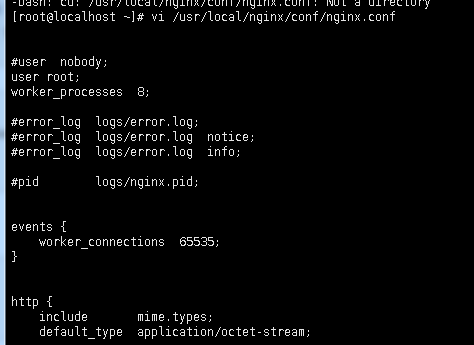Nginx+uwsgi安装配置
一、安装基础开发包
yum groupinstall "Development tools" yum install zlib-devel bzip2-devel pcre-devel openssl-devel ncurses-devel sqlite-devel readline-devel tk-devel
二、安装Python包管理
cd ~ wget https://pypi.python.org/packages/source/d/distribute/distribute-0.6.49.tar.gz tar xf distribute-0.6.49.tar.gz cd distribute-0.6.49 python2.7 setup.py install easy_install --version
pip包: https://pypi.python.org/pypi/pip
安装pip的好处是可以 pip list、pip uninstall 管理Python包, easy_install 没有这个功能,只有uninstall
三、安装uwsgi
uwsgi:https://pypi.python.org/pypi/uWSGI uwsgi参数详解:http://uwsgi-docs.readthedocs.org/en/latest/Options.html pip install uwsgi uwsgi --version #查看 uwsgi 版本
测试uwsgi是否正常:
新建test.py文件,内容如下:
def application(env, start_response): start_response('200 OK', [('Content-Type','text/html')]) return [b"Hello World"]
四、uwsgi配置:


然后在终端运行:
uwsgi --http 192.168.14.23:8086 --wsgi-file test.py

五、安装 Django
pip install django
六、配置django setting
设置settings.py,使用的数据库,如果使用mysql则需要设置数据库的地址和端口,如果设置sqlit则不需要进行更多设置
七:更新数据库:
python manage.py makemigrations
python manage.py migrate
八、运作django
python manage.py runserver XXXXXX:XXX

九、安装 Nginx
cd ~ wget http://nginx.org/download/nginx-1.5.6.tar.gz tar xf nginx-1.5.6.tar.gz cd nginx-1.5.6 ./configure --prefix=/usr/local/nginx-1.5.6 \ --with-http_stub_status_module \ --with-http_gzip_static_module make && make install
十、编译安装
[root@bogon nginx-1.6.2]#./configure --prefix=/usr/local/nginx --with-http_stub_status_module --with-http_ssl_module --with-pcre=/usr/local/src/pcre-8.38
[root@bogon nginx-1.6.2]#make
[root@bogon nginx-1.6.2]#make install
十一、查看nginx版本
[root@bogon nginx-1.6.2]# /usr/local/webserver/nginx/sbin/nginx -v
十二、Nginx 配置
[root@bogon conf]# /usr/sbin/groupadd www [root@bogon conf]# /usr/sbin/useradd -g www www
配置nginx.conf ,将/usr/local/nginx/conf/nginx.conf替换为以下内容
#user nobody; #user root; user www www; worker_processes 8; error_log /usr/local/nginx/logs/nginx_error.log crit; #日志位置和日志级别 #error_log logs/error.log; #error_log logs/error.log notice; #error_log logs/error.log info; #pid logs/nginx.pid; pid /usr/local/nginx/nginx.pid; worker_rlimit_nofile 65535; events { use epoll; worker_connections 65535; } http { include mime.types; default_type application/octet-stream; log_format main '$remote_addr - $remote_user [$time_local] "$request" ' '$status $body_bytes_sent "$http_referer" ' '"$http_user_agent" "$http_x_forwarded_for"'; #access_log logs/access.log main; server_names_hash_bucket_size 128; client_header_buffer_size 32k; large_client_header_buffers 4 32k; client_max_body_size 8m; sendfile on; tcp_nopush on; #keepalive_timeout 0; keepalive_timeout 65; tcp_nodelay on; fastcgi_connect_timeout 300; fastcgi_send_timeout 300; fastcgi_read_timeout 300; fastcgi_buffer_size 64k; fastcgi_buffers 4 64k; fastcgi_busy_buffers_size 128k; fastcgi_temp_file_write_size 128k; gzip on; gzip_min_length 1k; gzip_buffers 4 16k; gzip_http_version 1.0; gzip_comp_level 2; gzip_types text/plain application/x-javascript text/css application/xml; gzip_vary on; #gzip on; server { listen 8091; server_name localhost; #charset koi8-r; #access_log logs/host.access.log main; access_log /data/guest-master/access_log; error_log /data/guest-master/error_log; # max upload size client_max_body_size 75M; # adjust to taste location / { autoindex on; autoindex_exact_size off; autoindex_localtime on; #include ip_allow on; # root html; root /data/guest-master; #index index.html index.htm; uwsgi_pass 192.168.14.23:8086; include uwsgi_params; #include /etc/nginx/uwsgi_params; # the uwsgi_params file you installed access_log off; } location /static { alias /data/guest-master/sign/static; # your Django project's static files - amend as required #root /data/guest-master; } location ~.*.(gif|jpg|png|ico|jpeg|bmp|swf)$ { expires 3d; } location ~.*.(css|js)$ { expires 12h; } #error_page 404 /404.html; # redirect server error pages to the static page /50x.html # error_page 500 502 503 504 /50x.html; location = /50x.html { root html; } # proxy the PHP scripts to Apache listening on 127.0.0.1:80 # #location ~ \.php$ { # proxy_pass http://127.0.0.1; #} # pass the PHP scripts to FastCGI server listening on 127.0.0.1:9000 # #location ~ \.php$ { # root html; # fastcgi_pass 127.0.0.1:9000; # fastcgi_index index.php; # fastcgi_param SCRIPT_FILENAME /scripts$fastcgi_script_name; # include fastcgi_params; #} # deny access to .htaccess files, if Apache's document root # concurs with nginx's one # #location ~ /\.ht { # deny all; #} } # another virtual host using mix of IP-, name-, and port-based configuration # #server { # listen 8000; # listen somename:8080; # server_name somename alias another.alias; # location / { # root html; # index index.html index.htm; # } #} # HTTPS server # #server { # listen 443 ssl; # server_name localhost; # ssl_certificate cert.pem; # ssl_certificate_key cert.key; # ssl_session_cache shared:SSL:1m; # ssl_session_timeout 5m; # ssl_ciphers HIGH:!aNULL:!MD5; # ssl_prefer_server_ciphers on; # location / { # root html; # index index.html index.htm; # } #} }
检查配置文件ngnix.conf的正确性命令:
[root@bogon conf]# /usr/local/nginx/sbin/nginx -t

十三、启动 Nginx
[root@bogon conf]# /usr/local/nginx/sbin/nginx
访问站点

